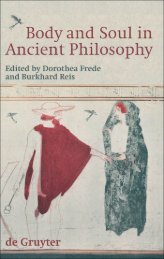Empedocles Redivivus: Poetry and Analogy in Lucretius
Empedocles Redivivus: Poetry and Analogy in Lucretius
Empedocles Redivivus: Poetry and Analogy in Lucretius
You also want an ePaper? Increase the reach of your titles
YUMPU automatically turns print PDFs into web optimized ePapers that Google loves.
Personification 33<br />
that his technique of us<strong>in</strong>g <strong>in</strong>stances of personification <strong>and</strong> then expla<strong>in</strong><strong>in</strong>g<br />
them may have <strong>in</strong>fluenced <strong>Lucretius</strong> <strong>in</strong> present<strong>in</strong>g Epicurus’ philosophy. 14<br />
In sum, <strong>in</strong> what follows it will be shown that <strong>Lucretius</strong> <strong>in</strong>terplays with<br />
<strong>Empedocles</strong>’ method <strong>and</strong> ideas <strong>in</strong> such a cunn<strong>in</strong>g way that he eventually<br />
turns personification <strong>in</strong>to an essential tool of communicat<strong>in</strong>g to his pupil<br />
the Epicurean truth of freedom <strong>and</strong> salvation. While so do<strong>in</strong>g, he strives to<br />
clarify his beliefs <strong>and</strong> ensure his fidelity to Epicurus’ orthodox doctr<strong>in</strong>e.<br />
2.2 PERSONIFICATION OF NATURAL FORCES<br />
AND MINIMAL ENTITIES<br />
<strong>Empedocles</strong> generally resorts to personification <strong>in</strong> order to present his<br />
pupil with a comprehensible image of both the motive forces of creation <strong>and</strong><br />
destruction <strong>and</strong> the unchangeable first beg<strong>in</strong>n<strong>in</strong>gs of th<strong>in</strong>gs, i.e. his roots.<br />
<strong>Lucretius</strong>, too, makes use of similar images <strong>in</strong> order to sketch the Epicurean<br />
physical system, regulated by self-prompted actions <strong>and</strong> obscure mechanistic<br />
processes. In this section, it will be argued that <strong>Empedocles</strong>’ <strong>and</strong> <strong>Lucretius</strong>’<br />
systems of personifications overlap <strong>in</strong> important respects <strong>and</strong> specific aff<strong>in</strong>ities<br />
<strong>in</strong> their use will be expounded. Moreover, it will be shown that, follow<strong>in</strong>g<br />
<strong>Empedocles</strong>’ example, <strong>Lucretius</strong> applies this literary device <strong>in</strong> a more<br />
systematic way. Like his predecessor, he does not limit himself to treat<strong>in</strong>g<br />
unseen primary elements <strong>and</strong> natural forces as isolated animate units; rather,<br />
by means of a more articulated imagery that reflects different manifestations<br />
<strong>and</strong> facets of human relationships, he succeeds <strong>in</strong> convey<strong>in</strong>g a variety<br />
of philosophical notions as well. As this cannot be a mere co<strong>in</strong>cidence, I will<br />
attempt to answer the question why <strong>Empedocles</strong> was particularly suitable<br />
for <strong>Lucretius</strong> as a model <strong>in</strong> this respect, what obstacles their philosophical<br />
discrepancies pose for <strong>Lucretius</strong> <strong>in</strong> this context, <strong>and</strong> how the Epicurean poet<br />
disentangles himself from the trap of deviat<strong>in</strong>g from his master’s doctr<strong>in</strong>e.<br />
Our start<strong>in</strong>g po<strong>in</strong>t will be rather basic occurrences of personification<br />
(deification 2.2.1, simple animation 2.2.2). Then, a more complex web of<br />
relationships from which both philosophers draw their imagery will be gradually<br />
sketched, a web that reflects the pyramid of human relations. In other<br />
words, while man himself is always at the centre, as we ascend the stages of<br />
human relations, <strong>in</strong>terrelations may vary rang<strong>in</strong>g from more primitive <strong>and</strong><br />
unconscious processes of attraction <strong>and</strong> repulsion (sexual imagery or images<br />
of friendship <strong>and</strong> hostility 2.2.3.1) to more complicated <strong>and</strong> structured associations;<br />
those, depend<strong>in</strong>g on the identity <strong>and</strong> number of persons <strong>in</strong>volved,<br />
necessitate formal legal agreements <strong>in</strong> order to acquire a certa<strong>in</strong> temporary<br />
coherence (socio-political imagery 2.2.3.2). Conversely, as the equilibrium






![[Niall_Livingstone]_A_Commentary_on_Isocrates'_Busiris](https://img.yumpu.com/51449110/1/163x260/niall-livingstone-a-commentary-on-isocrates-busiris.jpg?quality=85)

![[Richard_Sorabji]_Self__Ancient_and_Modern_Insigh(BookFi.org)](https://img.yumpu.com/30857691/1/174x260/richard-sorabji-self-ancient-and-modern-insighbookfiorg.jpg?quality=85)




